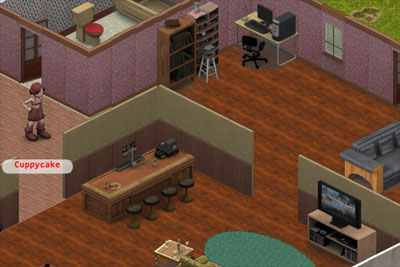
Shortly before Christmas it was announced that Metaplace was closing its doors to the public on January 1st 2010. Metaplace (which I briefly wrote about last year) was the web-based virtual world construction kit masterminded by Raph Koster (of Ultima Online, Star Wars Galaxies and Theory of Fun fame), had shown a great deal of promise but had failed to generate enough interest (nor presumably revenue) to justify its continued upkeep.
This is a great shame. Metaplace’s core concept – that appropriately designed virtual worlds could be as frictionless to create and interact with as YouTube videos – is still a compelling one, and one that hopefully will some day be solved.
While I dipped into Metaplace occasionally (attending in-world events and making a couple of small sandbox worlds in an effort to learn the tools), I can’t claim to have put in the time and effort exploring the worlds on offer to give an authoritative account of what the community achieved. While the technology was theoretically capable of representing worlds in a variety of ways (3D, 2D, birdseye, isometric, even plain text), most of the content was geared towards tile-based isometric worlds at around the level of sophistication of Ultima Online. It could perhaps be best described as an update of DikuMUD for the broadband age.
While most of the worlds that users made were fairly small and crude, the breadth of subject matter was impressive. Memorable worlds that I stumbled upon included a recreation of 1880s Whitechapel (populated with Ragnarok Online sprites) intended to teach about the Ripper murders, a virtual hospital, various explorable galleries built by graphic designers and musicians, a Star Trek ship, a transgender memorial garden and (depressingly inevitably) a “pro-traditional marriage” advocacy centre. It was possible to embed YouTube videos, audio streams and web links directly into worlds, making it easy for anyone to populate their worlds with entertaining content. Any world could be linked to any other, making exploration very organic and frequently surprising.
In fact the only things people didn’t seem to be making (at least that I saw) were games or MMORPGs. A project to build a cyberpunk world and role-playing system (MetaPunk) started enthusiastically but soon fizzled. There certainly didn’t seem to be any large-scale community projects of the kind that have been seen in Garry’s Mod for Half-Life 2 or the various modding, homebrew and open source communities.
One possible reason for this was that the unwavering commitment to making Metaplace fully accessible and editable via the web, while noble in intent, drastically narrowed the scope of what was feasible for end users to experience and build.
The sub-50k game client (implemented in Flash) loaded as quickly as a YouTube player, but would then spend a lot of time loading in all the world assets on the fly, resulting in a lot of choppiness. The lack of prediction or any sort of physics ruled out making anything that involved real-time interaction with the world or other users. And tile-based isometric worlds, while cheap in terms of bandwidth, are by their nature very labour-intensive to build, brittle (small changes requiring lots of fiddly rework) and limited in scope for interaction. Faster, 3D, OS-native clients were mooted but never materialised.
The problem was compounded by the editing tools. All aspects of created worlds (including asset management and scripting) had to be carried out through a monolithic Flash application, with a cumbersome and glitchy UI reminiscent of the homespun “windowing” systems used by DOS applications in the days before modern graphical OSes. Every editing operation requiring a round trip to the server slowed the pace of editing to a crawl and quickly sapped my enthusiasm.
What else? It could be argued that there was too much focus on the theory rather than practical applications. Game developers typically build engines with the needs of a specific application in mind. Metaplace conspicuously lacked any major ‘in-house’ project to guide its direction and exploit its strengths.
I expect that such a project would have required far more money and manpower that the company had at its disposal. In which case, the logical solution would have been to recruit the most heavily invested parts of the community to collaborate on building a ‘flagship’ world/network of worlds.
Instead, we got “Metaplace Central”, the virtual world equivalent of a synthesizer demo track – a sprawling, progressively more cluttered lobby area, locked off from user editing and stuffed with gaudy pre-rendered art and rickety minigames. (To be fair, there were themed world-building contest/festivals, but these oddly didn’t place much emphasis on large-scale collaboration, resulting in, for instance, dozens of interpretations of the “cafe” theme.)
Finally, I suspect (perhaps completely unfairly) that the Metaplace user-base was skewed towards virtual world scholars, hardcore multi-MMO/MUD veterans and Second Life, well, freaks. While such a crowd can obviously bring a lot of informed discourse to the table, they are perhaps too willing to overlook the rough edges and foibles of the genre that drive away the mainstream web users and gamers that Metaplace needed to attract.
I suspect that if anyone does succeed at turning user-generated virtual worlds into a mainstream commodity, their approach will be much less pure than Metaplace (maybe even growing from an editor for a specific existing game) and several steps removed from the traditional denizens of the MUD-DEV mailing list.
Tags: commentary, flash, Metaplace, MMO, Raph Koster, second life, ultima online, virtual world
